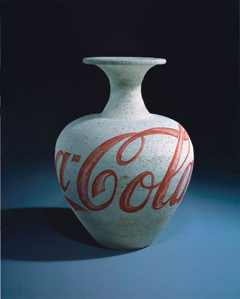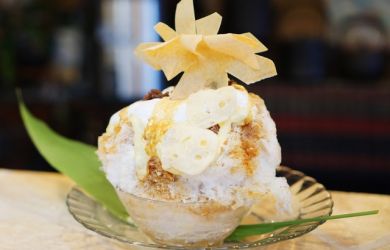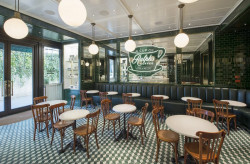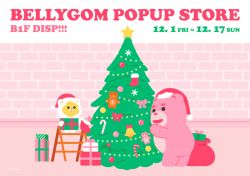
September 10, 2009
Ai Weiwei
The Mori presents drab minimalism and toothless iconoclasm
By Metropolis
Originally published on metropolis.co.jp on September 2009

Coca Cola Vase, 1997, vase from the Tang Dynasty (618-907) and paint, 24 x 18cm
The term “art,” if it does anything at all, should greatly raise expectations. Going to see it, we automatically expect something intense, elevated and unique. Accordingly, when an exhibition doesn’t deliver, we are left with two main options: to blame the artist, or to blame ourselves.
Those lacking confidence are likely to resort to the latter course, perhaps believing a lack of sophistication and intellectual insight is at fault. In order to avoid any open embarrassment, they may even pretend to “get” the artist. Those of a more confident nature will blame the artist, but faced with a formidable artistic reputation, might be reluctant to be openly critical.
The end result of all this doublethink is that bad artists can sometimes have extremely flourishing careers. After visiting the Mori Art Museum to see “Ai Weiwei: According to What?” a major solo show by this “leading figure among the Chinese artists of his generation,” I am convinced that this excessively touted talent represents exactly this kind of phenomenon.
The first thing that strikes the visitor is the lack of imagination. This dullness is first sounded by Cubic Meter Tables (2009), a row of 13 bespoke wooden cubes, exactly one meter square, assembled by Chinese craftsmen who, given the prices successful Chinese art now fetches, are clearly not employed under the Fair Trade system.

<em>Ton of Tea</em>, 2006, compressed tea, 100 x 100 x 100cm
The sterility of the minimalist cubic theme is hammered home with yet more metric cubes—rosewood and compressed tea—followed by other simplistic geometric forms and China-shaped chunks of wood. This is all so dreary that you automatically activate your irony switch and conclude that the artist is having a grand old laugh at the pretention of the art world. The sad truth is that he isn’t.
Next we encounter two big bowls of pearls. A third bowl should be in place for the art intelligentsia to pour overworked symbolism into, as, according to the exhibition catalogue, the pearls represent “the beauty of the artificial and mass produced.” But you can enjoy similar visual semantics, for free, in most shopping centers.
The real puzzle and pleasure of an exhibition like this is to work out why such a creatively challenged artist has been lionized by the establishment. The truth is that Ai is not a success for what he produces, but for what he represents. He is a nexus for a number of important reference points and trendy associations: his father was a victim of the Cultural Revolution who was exiled to the remote Sinkiang province, where the young Weiwei grew up. In the ’80s the artist moved to New York, where he seems to have hung out in the right circles, and returned to China just as Deng Xiaoping’s economic liberalization kick-started the Chinese economy and made some suspect that China was also an awakening artistic giant.

Cubic Meter Tables, 2006, huali wood 13 pieces, each 100 x 100 x 100cm
Ai’s talentlessness led him to specialize in a slightly truculent—but not enough to get arrested—iconoclasm that played well to the Western liberal dream of a gradually democratizing China. Smashing Han dynasty vases and placing Tang dynasty figurines inside vodka bottles may give Western curators a thrill, but is unlikely to get the tanks rolling over Tiananmen Square again. The obvious propaganda benefits that someone like Ai had for suggesting that China was more liberal than it was were recognized in the run-up to the Beijing Olympics, when he was chosen to participate in designing the famous “Bird’s Nest” stadium.
Since then, Ai has conspicuously been blotting his copybook with the authorities by listing the names of those killed in the 2008 Sichuan Earthquake on his blog and making a giant snake from schoolbags to commemorate the children killed by poor building standards. So, what has happened to the artist as a result? Has his principled stand seen him imprisoned and tortured, or perhaps placed under Suu-Kyi-style house arrest? No. Much better than that: officials have temporarily blocked his Twitter account—the greatest accolade you can give to a cutting edge contemporary artist these days, it seems.
Ai Weiwei. According to What? Various media. Until Nov 8, ¥500 (MS and under)/¥1,000 (HS, univ)/¥1,500 (adult). MAM Project 009: Koizumi Meiro. Video. Until Nov 8, ¥500 (MS and under)/¥1,000 (HS, univ)/¥1,500 (adult). 53F Mori Tower Roppongi Hills, 6-10-1 Roppongi, Minato-ku. Tel: 03-5777-8600. Open Wed-Mon 10am-10pm, Tue 10am-5pm. Nearest stn: Roppongi. www.mori.art.museum/eng





